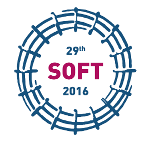Speaker
Takumi Chikada
(Graduate School of Integrated Science and Technology)
Description
Tritium permeation through structural materials in fusion blankets is one of the most important issues in terms of a fuel loss and radiological hazard. Tritium permeation barriers (TPBs) have been developed for several decades, and erbium oxide (Er2O3) coatings have recently been intensively studied as TPBs. However, irradiation effects in TPB coatings on hydrogen isotope permeation have not been elucidated in spite of a severe radiation environment in the blanket region. In this study, the correlation between irradiation damages generated by iron ion at elevated temperature and deuterium permeation in the Er2O3 coatings has been investigated.
Er2O3 coatings were fabricated by filtered vacuum arc deposition on reduced activation ferritic/martensitic steel substrates. Iron irradiation on the coated samples has been conducted using a tandem accelerator DuET at Kyoto University. The ion energy and the irradiation temperature were 6.4 MeV of Fe3+3+ at 873 K. The average displacement was 0.01‒1.0 dpa, and the damage was distributed in the whole thickness of the coatings (1 μm) according to a calculation. Finally, deuterium permeation measurements have been performed using a gas-driven permeation system.
Deuterium permeability of the coated samples irradiated to 0.1 dpa at 873 K was 75‒80% lower than that of unirradiated one, and decreased by a factor of up to 3200 in comparison with that of an uncoated substrate. In addition, the activation energy of permeation was estimated to be 91 kJ mol‒1‒1, which was clearly higher than that of the unirradiated coating (60 kJ mol‒1‒1). These results indicate that the irradiation under elevated temperature contributes to the modification of the grain structure of the coating by irradiation damage introduction and recovery. Irradiation temperature and damage concentration dependences will be also discussed in the presentation.
Co-authors
Freimut Koch
(Plasma Edge and Wall, Max-Planck-Institut für Plasmaphysik, Boltzmannstrasse 2, Garching, 85748, Germany)
Jumpei Mochizuki
(Graduate School of Integrated Science and Technology, Shizuoka University, Shizuoka, Japan)
Kiyohiro Yabuuchi
(Institute of Advanced Energy, Kyoto University, Gokasho, Uji, Kyoto 611-0011, Japan)
Seira Horikoshi
(Graduate School of Integrated Science and Technology, Shizuoka University, Shizuoka, Japan)
Takumi Chikada
(Graduate School of Integrated Science and Technology, Shizuoka University, Shizuoka, Japan)
Yasuhisa Oya
(Graduate School of Integrated Science and Technology, Shizuoka University, Shizuoka, Japan)

